In the rapidly evolving world of gaming and streaming, the clarity and quality of audio transmission have become paramount. As 2024 unfolds, the gaming microphone sector continues to witness significant advancements, offering an array of products designed to meet the diverse needs of the gaming community. From enhancing in-game communication to delivering broadcast-quality streams, the right gaming microphone can dramatically elevate the audio experience. This selection not only affects the immersion and performance of players but also plays a crucial role in audience engagement for streamers. With technology pushing the boundaries of what gaming microphones can achieve, selecting the ideal microphone is more crucial than ever, underscoring the need for informed choices in this competitive market.
Table of Contents
1. Exploring types and uses of gaming microphones
2. 2024 gaming microphone market insights
3. Key considerations for microphone selection
4. Spotlight on 2024’s leading gaming microphones
5. Conclusion
Exploring types and uses of gaming microphones
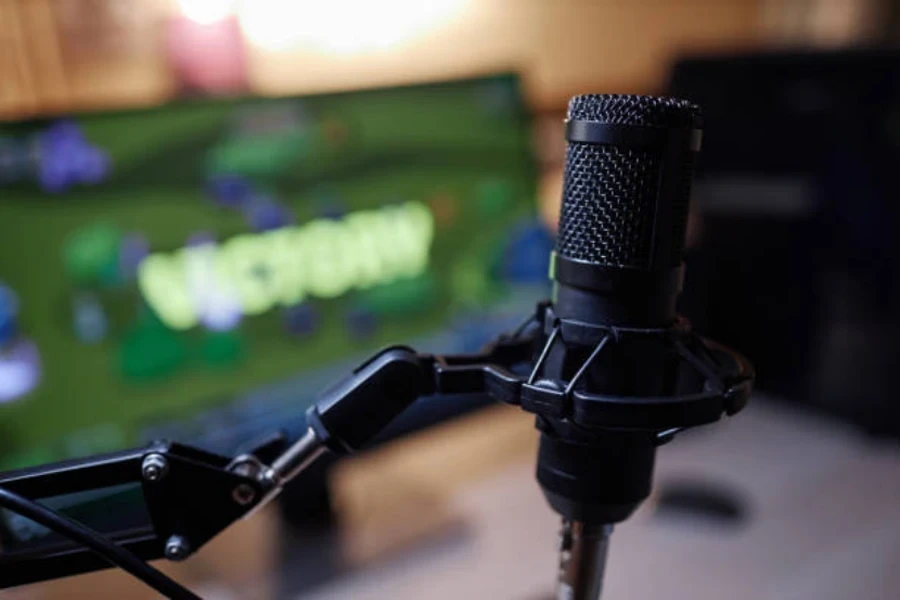
The landscape of gaming microphones in 2024 reveals a sophisticated array of technologies tailored to enhance the gaming and streaming experience. Understanding the nuances between different microphone types and their specific applications across gaming genres is vital for making informed decisions in this dynamic field.
Differentiating microphone types
In the gaming and streaming world, the choice of microphone can dramatically affect the quality of audio communication and the overall experience for both the user and their audience. Understanding the different types of gaming microphones and their respective strengths is crucial. Here’s a breakdown focusing on condenser versus dynamic microphones and USB versus XLR connections.
Condenser vs. dynamic microphones
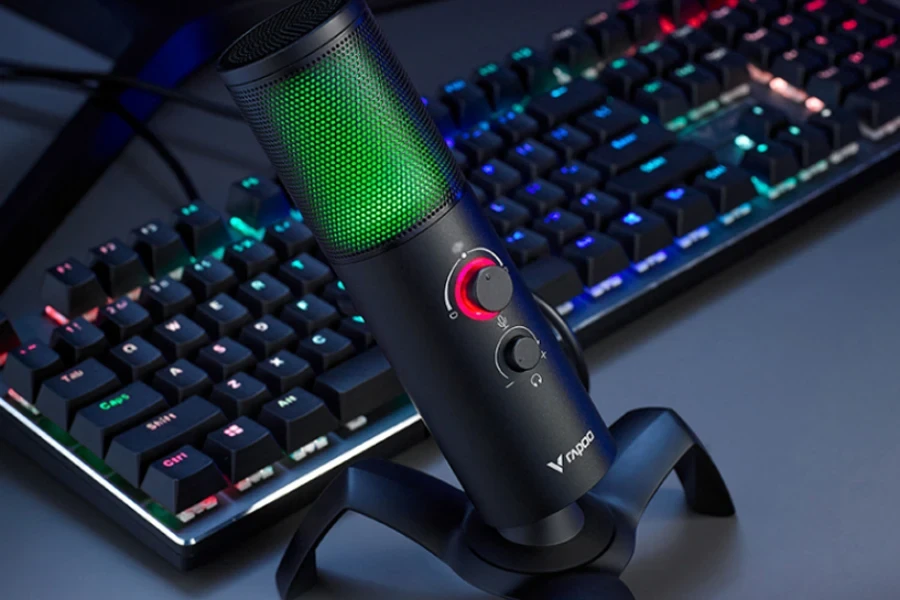
Condenser microphones:
Sensitivity: Condenser microphones are highly sensitive and capable of capturing a wide range of sounds, from the subtle nuances of a voice to the intricate details of background noises. This makes them particularly suitable for environments where clarity and detail are paramount.
Power Requirements: They require external power, typically provided by phantom power through an audio interface, mixer, or USB connection, which can be a consideration in your setup.
Ideal Use: Due to their sensitivity, condenser mics are best used in controlled environments where background noise can be minimized. They are favored by streamers and content creators who require crisp, clear audio for their broadcasts.
Dynamic microphones:
Durability: Known for their robustness, dynamic microphones can withstand rough handling and high sound pressure levels without distortion. This makes them less delicate compared to condenser mics.
Background Noise: They excel at isolating the speaker’s voice from background noise, thanks to their narrower range of sound sensitivity. This feature is especially beneficial in live gaming environments or places with significant background noise.
Power Requirements: Dynamic microphones do not require external power, making them more versatile and easier to set up in various environments.
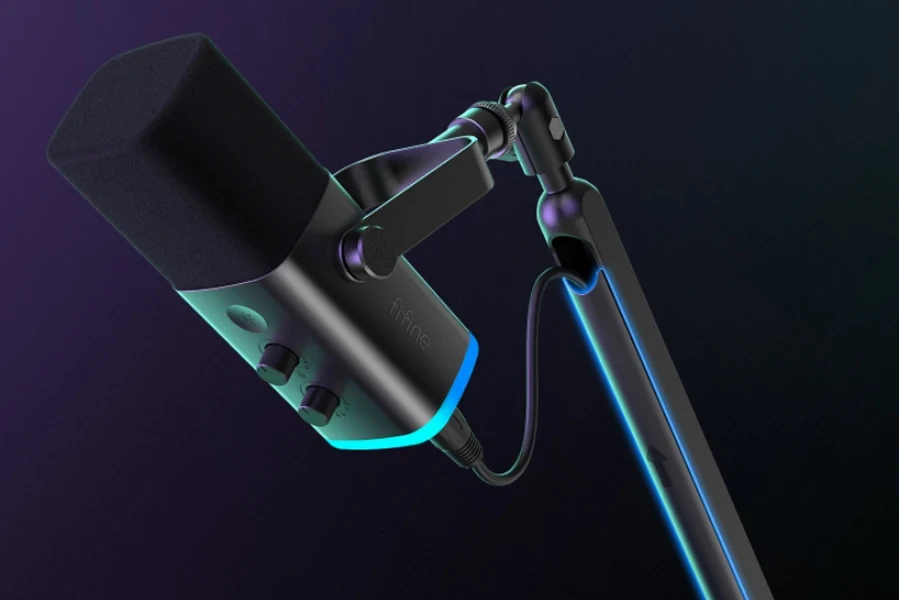
USB vs. XLR connections
USB microphones:
Convenience: USB microphones are prized for their plug-and-play convenience, allowing gamers and streamers to easily connect the microphone to a computer without needing additional equipment.
Quality: While historically considered to offer lower quality than XLR microphones, advancements in technology have significantly improved their performance, making them a viable option for professional-quality recordings.
Ideal Use: Perfect for gamers and streamers looking for a straightforward setup without compromising on sound quality. They are particularly appealing to those new to streaming or recording.

XLR microphones:
Professional Audio Quality: XLR connections are standard in the professional audio industry, offering superior sound quality and flexibility in audio processing. This is due to the analog signal path which can handle higher sound pressure levels without distortion.
Versatility: XLR microphones require an audio interface or mixer, which adds to the setup complexity but provides greater control over the audio signal, such as gain adjustment, compression, and EQ settings.
Ideal Use: Suited for environments where audio quality cannot be compromised and where the user is comfortable managing more complex audio setups. This includes professional studios and live performances.
Impact on gaming audio
The choice between condenser and dynamic microphones, as well as USB and XLR connections, impacts gaming audio by affecting clarity, ease of use, and the ability to convey emotions and commands clearly in game play and streaming. Condenser mics, with their sensitivity, are excellent for capturing the full spectrum of a player’s voice in quieter settings, while dynamic mics are better suited for noisy environments. USB mics offer simplicity and ease for gamers and streamers who prefer a straightforward setup, whereas XLR mics cater to those seeking professional-grade audio quality and control.
In summary, the selection of a gaming microphone hinges on the user’s specific needs, environment, and the level of audio quality desired. Whether opting for the detailed sound capture of a condenser mic, the durability of a dynamic mic, the convenience of USB, or the professional quality of XLR, understanding these distinctions is key to enhancing the gaming and streaming experience.
Primary uses across gaming genres

Gaming microphones serve as a critical tool across various gaming genres, each with unique requirements and challenges that necessitate specific microphone features for optimal performance. The primary uses of gaming microphones span from enhancing communication between players to ensuring that streamers can deliver clear, engaging content to their audiences. Let’s explore how different gaming genres such as Massively Multiplayer Online (MMO) games, First-Person Shooter (FPS) games, and streaming activities benefit from specialized microphone attributes.
MMO games
Massively Multiplayer Online (MMO) games are renowned for their expansive worlds and the complex interactions they facilitate among large groups of players. In such environments, clear communication is paramount.
Noise Cancellation: Given the collaborative nature of MMOs, where strategy and coordination play pivotal roles, microphones with effective noise cancellation ensure that commands and conversations are transmitted clearly, without the distraction of background noise.
Omnidirectional or Cardioid Pickup Patterns: A microphone with an omnidirectional pattern can capture sound from all directions, which is beneficial for gamers who may have multiple speakers in the same room. However, a cardioid pattern, which captures sound primarily from the front, can be more desirable for individual players looking to minimize room noise.
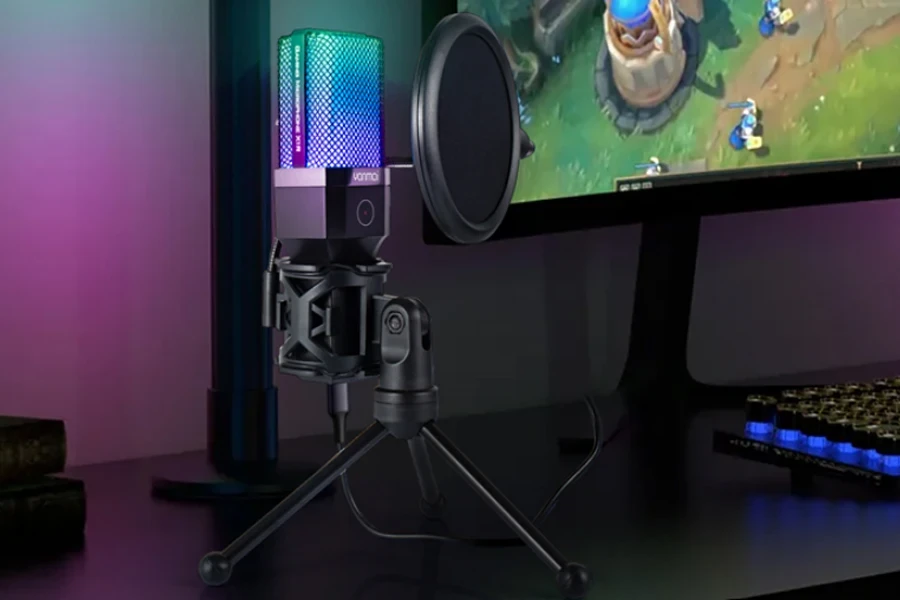
FPS games
First-Person Shooter (FPS) games are fast-paced and often rely on split-second decision-making. The ability to quickly and clearly communicate with team members can be the difference between victory and defeat.
Low Latency: In FPS games, where timing and quick reactions are crucial, microphones with low latency ensure that there is minimal delay between speaking and the audio being heard by teammates.
Durability: Given the intense nature of these games, a durable microphone that can withstand frequent use (and occasional frustration) is a must. Dynamic microphones are often preferred for their robustness.
Streaming
Streaming activities, whether they involve gameplay, commentary, or both, demand high-quality audio that can engage listeners and elevate the overall viewing experience.
Superior Sound Quality: For streamers, condenser microphones are often the go-to choice because of their superior sound quality. They can capture a wide range of frequencies and nuances in the voice, making the streamer’s commentary more engaging and professional-sounding.
Adjustable Gain Control: Streaming often involves balancing game audio with commentary. Microphones with adjustable gain control allow streamers to fine-tune their audio on the fly, ensuring that their voice is neither too loud nor too soft against the background of the game.

General Considerations
Across all genres, versatility and compatibility with different platforms and setups are also crucial. USB microphones offer plug-and-play convenience, making them a popular choice for gamers and streamers who value ease of use. However, for those seeking the highest audio quality and don’t mind a more complex setup, XLR microphones connected through an audio interface may be preferred.
In summary, the primary uses of gaming microphones across different genres highlight the need for features tailored to the specific demands of each gaming experience. From the strategic discussions in MMOs and the rapid communications in FPS games to the content creation needs of streamers, selecting the right microphone with the appropriate features can significantly enhance performance and audience engagement.
2024 gaming microphone market insights

The gaming microphone market in 2024 continues to evolve, influenced by a blend of technological advancements and changing consumer preferences. Insights into current trends and projected market growth shed light on the dynamics shaping this industry, offering valuable perspectives for those involved in the production and distribution of gaming microphones.
Current trends shaping the market
Key players such as Focusrite, RØDE Microphones, AKG, Samson Technologies, Ahuja Sound Solutions, Shure, Behringer, and MXL Microphones are at the forefront, driving innovation and catering to evolving consumer demands.
Technological advancements play a pivotal role in molding consumer choices within the gaming microphone sector. AI noise cancellation technology stands out as a significant innovation, enhancing the clarity of voice communication by filtering out background noises. This feature is particularly appealing to gamers and streamers operating in environments where controlling ambient noise is challenging. Furthermore, RGB lighting adds an aesthetic dimension to gaming setups, allowing users to customize their gear to match their personal style or gaming rig. These trends highlight the industry’s shift towards microphones that offer not only superior audio performance but also customization and convenience.
Projected growth and consumer preferences

The global microphone market, encompassing gaming microphones, was valued at USD 6.33 billion in 2021. It is expected to expand at a compound annual growth rate (CAGR) of 5.4% from 2022 to 2030, indicating a vibrant and growing sector influenced by technological innovations and shifting consumer behaviors. Moreover, the Gaming Accessories Market is currently valued at USD 10.72 billion and is anticipated to grow to USD 17.91 billion by the end of the forecast period, marking a compound annual growth rate (CAGR) of 10.8%. This significant growth underscores the expanding demand for gaming accessories, fueled by the surge in gaming and esports, which necessitates accessories that enhance performance through speed, precision, and reliability.
The gaming and e-sports industries have witnessed remarkable growth, driving demand for high-quality gaming microphones. The rise in online streaming, competitive gaming, and content creation has created a robust market for microphones that cater to various needs, from casual gaming to professional broadcasting. Consumer preferences are increasingly leaning towards microphones that offer a combination of exceptional sound quality, ease of use, and features like wireless connectivity and integration with gaming ecosystems. The demand for versatile microphones compatible with multiple devices and platforms is also on the rise, reflecting the diverse nature of gaming setups and streaming studios.
The preference for specific microphone features varies across different user segments. Casual gamers may prioritize ease of use and convenience, opting for USB microphones with plug-and-play functionality. In contrast, professional streamers and content creators often seek out microphones with advanced audio customization options, such as XLR microphones that can be fine-tuned with external mixers and audio interfaces. The increasing interest in creating immersive audio experiences has also led to a demand for microphones capable of capturing spatial audio, enhancing the realism of gaming and virtual environments.
As the gaming microphone market continues to expand, these insights into current trends and consumer preferences underscore the importance of innovation and adaptability. Manufacturers and retailers must stay attuned to these dynamics to meet the evolving needs of gamers and content creators, ensuring their offerings resonate with the expectations of a diverse and growing audience.
Key considerations for microphone selection
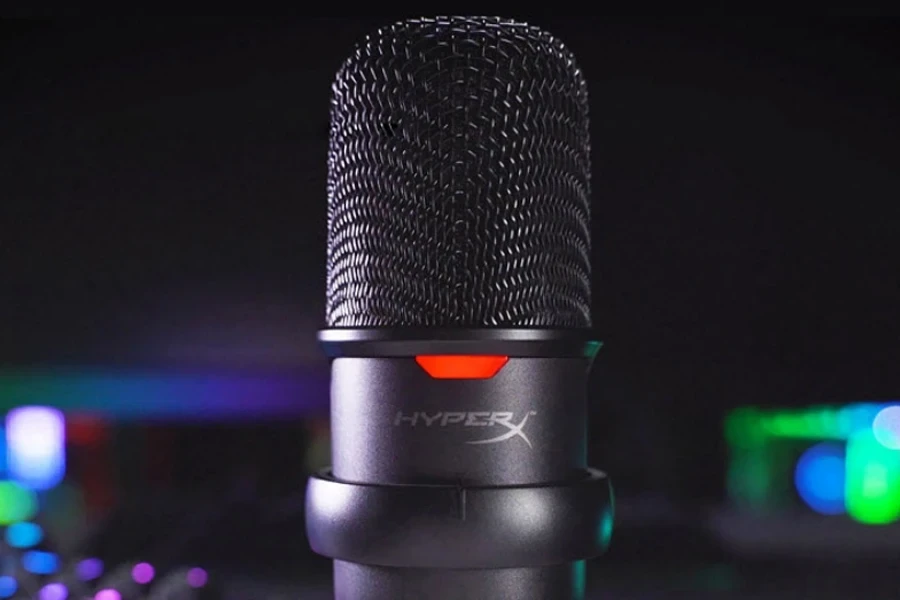
When selecting a gaming microphone, several critical factors must be considered to ensure optimal performance and integration with gaming setups. These considerations are vital for both casual and professional environments, affecting sound quality, compatibility, and the overall gaming experience.
Assessing sound quality and pickup patterns
Understanding the nuances of sound quality and pickup patterns is essential. These elements significantly impact the microphone’s performance in various gaming scenarios, from solo streaming sessions to competitive gaming environments.
Sound quality
Sound quality in gaming microphones is influenced by several factors, including frequency response, sensitivity, and signal-to-noise ratio:
Frequency Response: This refers to the range of frequencies a microphone can capture. A broader frequency response range can capture more detail in the voice, enhancing clarity and richness. For gaming, a frequency range of 20 Hz to 20 kHz is ideal as it covers the spectrum of human hearing.
Sensitivity: Microphone sensitivity indicates how well a microphone can pick up quiet sounds. Higher sensitivity is crucial for capturing nuanced vocal expressions, essential for immersive storytelling or dynamic commentary during streaming.
Signal-to-Noise Ratio: This metric measures the difference in level between the intended audio signal and background noise. A higher signal-to-noise ratio means less background noise is captured, critical for clear communication in team-based games or during live streams.
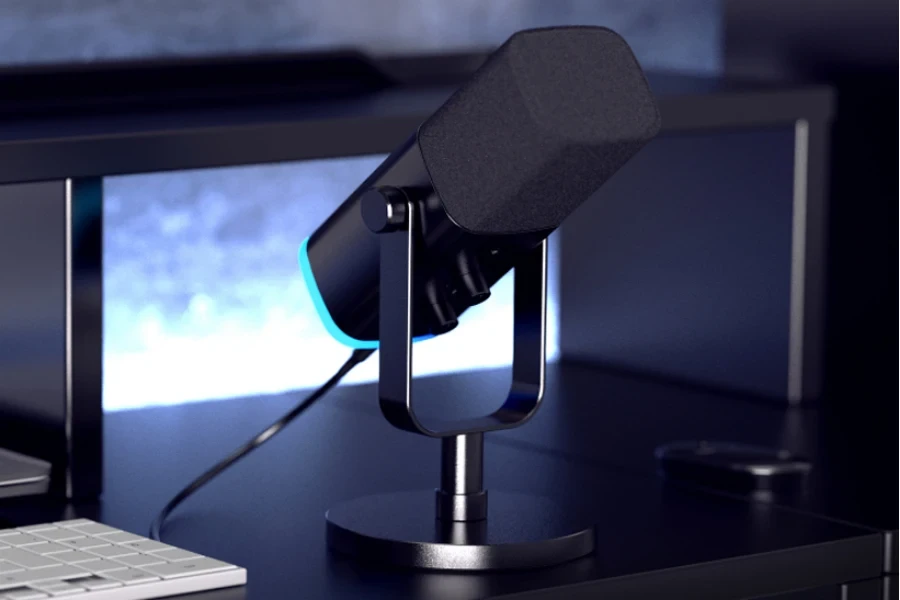
Pickup patterns
Different gaming setups benefit from specific pickup patterns—cardioid, bidirectional, and omnidirectional—each suited to particular gaming environments:
Cardioid Microphones: Featuring a heart-shaped pattern, cardioid microphones capture sound primarily from the front. They are ideal for individual streamers or gamers, as they minimize background noise and focus on the user’s voice. An example is the Audio-Technica AT2020, favored for its excellent cardioid pickup pattern that isolates the speaker’s voice from unwanted ambient sound.
Bidirectional Microphones: These microphones pick up sound from the front and back but reject sound from the sides. They’re perfect for interviews or co-op gaming where two participants face each other. The Blue Yeti microphone is a notable example, offering selectable pickup patterns, including bidirectional, allowing for versatile use across different gaming scenarios.

Omnidirectional Microphones: Omnidirectional mics capture sound from all directions equally, making them suitable for multi-player sessions in the same room, ensuring everyone is heard clearly. However, they can pick up ambient noise, so they’re best used in controlled environments. The Rode NT-USB Mini offers an omnidirectional pattern that works well for round-table discussions or gaming with a group.
Each pickup pattern serves different gaming and streaming needs, from solo adventures where clarity and focus on a single voice are crucial, to interactive sessions with multiple participants. Selecting the right pattern ensures the microphone enhances the gaming experience, providing clear and immersive audio that complements the visual gameplay.
In conclusion, the choice of a gaming microphone requires careful consideration of sound quality and pickup patterns. By understanding these key aspects, gamers and streamers can select a microphone that best fits their gaming environment, ensuring optimal audio performance that matches the immersive visual experiences of modern gaming.
Evaluating compatibility and connectivity

In the realm of gaming microphones, compatibility and connectivity are critical factors that determine how well a microphone integrates with your existing setup. The primary distinction in connectivity options lies between USB and XLR microphones, each offering unique advantages and challenges.
USB Microphones
Benefits:
Plug-and-Play Convenience: USB microphones are celebrated for their ease of use. They can be directly connected to a PC or laptop without the need for additional hardware, making them an ideal choice for gamers and streamers who prioritize quick setup.
Versatility: Many USB microphones are compatible with standard operating systems without the need for special drivers or software, ensuring they work seamlessly with a wide range of devices, including consoles and mobile devices through adapters.
Integrated Audio Interface: USB microphones have an inbuilt audio interface, which simplifies the audio recording process. This can be particularly beneficial for individuals who are new to content creation or streaming.
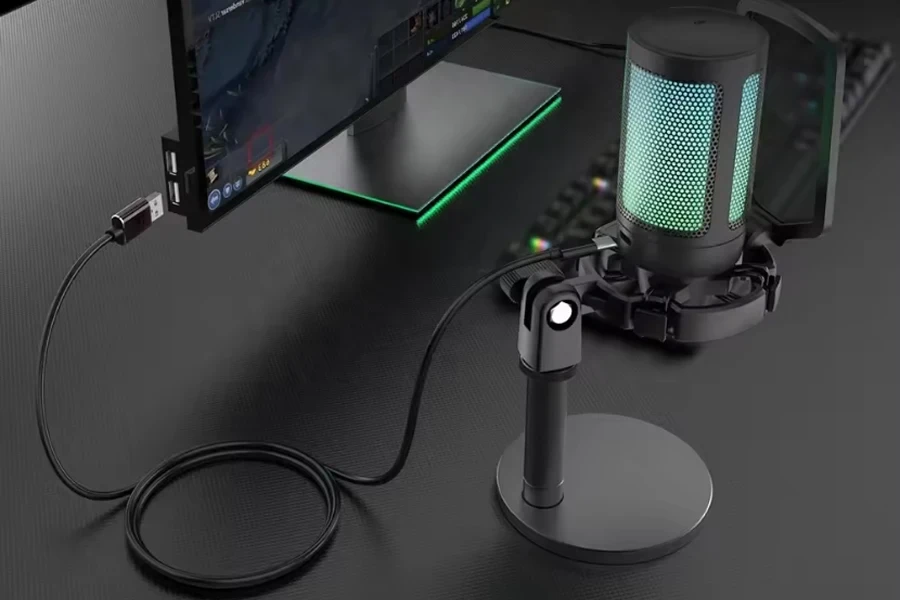
Limitations:
Audio Quality: While recent advancements have significantly improved the audio quality of USB microphones, they generally do not match the superior sound quality provided by XLR microphones. This is due to the inherent limitations in the analog-to-digital conversion that takes place within the microphone itself.
Less Control Over Sound: USB microphones offer fewer options for audio customization and control compared to XLR setups. This can be a drawback for professional streamers or content creators who require detailed control over their audio settings.
XLR Microphones
Benefits:
Superior Sound Quality: XLR microphones provide professional-grade audio quality, making them a staple in broadcasting and music recording. The analog signal path of XLR microphones allows for a richer and more detailed sound capture.
Greater Flexibility and Control: When paired with an audio interface or mixer, XLR microphones offer extensive control over sound settings, including gain, EQ, and compression. This level of control is crucial for achieving the best possible audio in professional settings.
Durability and Reliability: XLR connectors and cables are designed to withstand the rigors of studio and live environments, offering a more durable and reliable connection than USB.
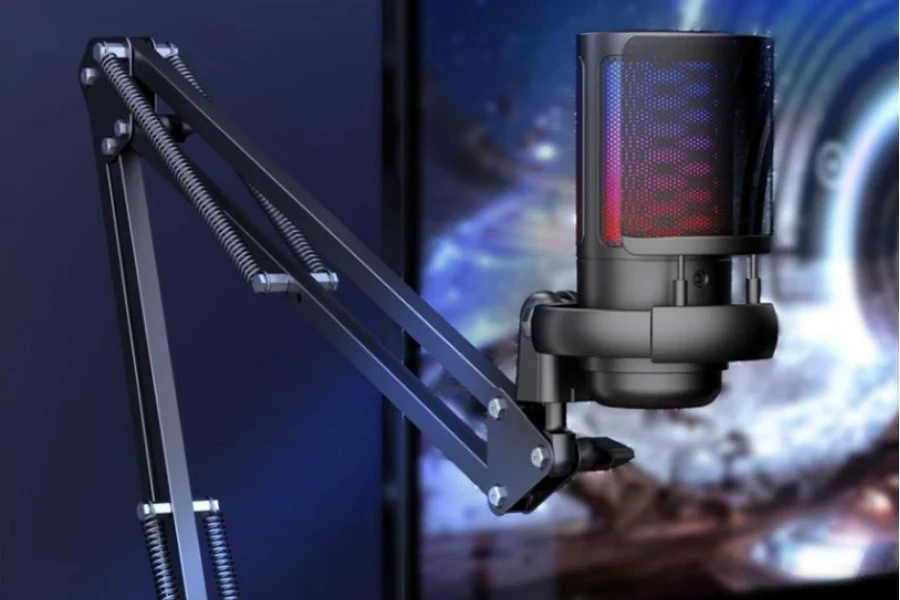
Limitations:
Complexity and Cost: An XLR microphone setup requires an audio interface or mixer, which adds to the overall cost and complexity of the system. This can be a barrier for those who are just starting or for gamers who prefer a more straightforward setup.
Compatibility: While XLR microphones offer unmatched audio quality, they are not as straightforward to connect to computers or gaming consoles without the appropriate audio interface, which can limit their plug-and-play usability.
Compatibility with devices and platforms
When considering a microphone for gaming, it’s essential to assess its compatibility with your preferred gaming platform. USB microphones, with their direct connectivity, are generally more versatile across different devices, including PCs, Macs, and with the appropriate adapters, even mobile devices and gaming consoles. On the other hand, XLR microphones, while offering superior audio quality, typically require more specialized equipment and are thus more suited to PC-based setups or professional studios where such equipment is already in place.
In conclusion, the choice between USB and XLR microphones hinges on balancing the need for quality, control, and convenience against the specifics of your gaming setup and personal preferences. USB microphones offer an accessible entry point for high-quality audio, while XLR microphones cater to those seeking the highest audio fidelity and control over their sound environment.
Understanding design and aesthetic appeal

The design and aesthetic appeal of a gaming microphone contribute significantly to the overall gaming or streaming setup, influencing both the functionality and the visual harmony of the environment. When selecting a microphone, considering how its design and build quality can enhance the gaming experience is crucial.
Design features
Ergonomics and Functionality: A well-designed microphone should not only look good but also be ergonomically designed for ease of use. For example, microphones with a swivel mount can offer flexibility in positioning, which is crucial during intense gaming sessions or dynamic streaming broadcasts. The Rode PSA1 boom arm is a popular choice for gamers and streamers, offering a range of motion that can accommodate various setups and sitting positions.
Size and Shape: The physical size and shape of a microphone can affect both its audio capture capabilities and how it fits within a space. Compact microphones with a smaller footprint, like the Elgato Wave 3, are favored in setups where desk space is at a premium, while larger microphones with more presence, such as the Blue Yeti, can serve as a focal point in a streaming setup.
Customization Options: Many gaming microphones come with customizable options, such as interchangeable covers or RGB lighting, allowing users to tailor the appearance of their microphone to match their setup or personal brand. The HyperX QuadCast S, for example, features dynamic RGB lighting effects that can be customized through software to match gaming rigs or mood lighting.
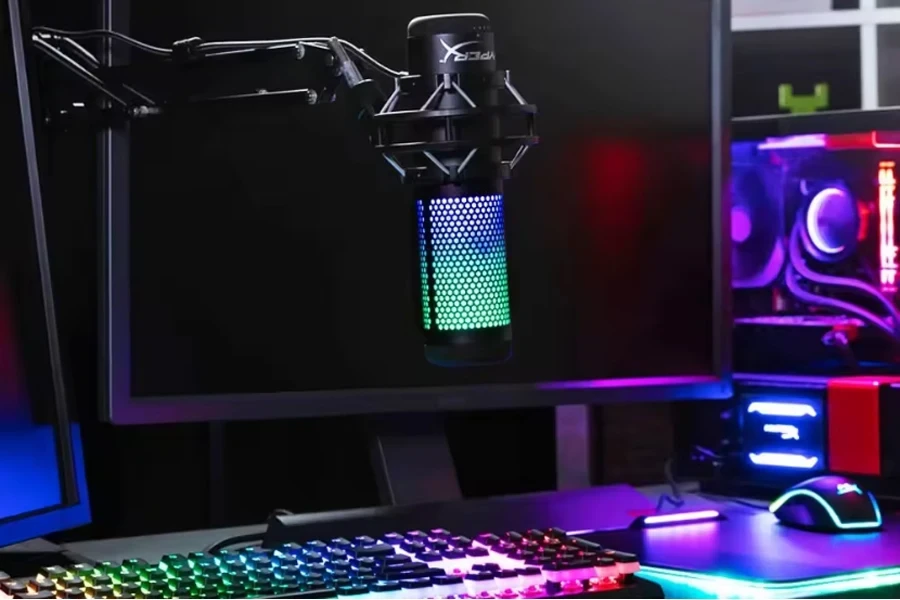
Build quality
Materials and Durability: High-quality materials not only contribute to the durability of a microphone but also to its aesthetic appeal. Metal construction, as seen in microphones like the Shure SM7B, offers both a premium feel and the durability needed for long-term use. In contrast, microphones with plastic components may be lighter and more affordable but can lack the same level of prestige and longevity.
Sound Isolation Features: Design elements that contribute to sound isolation, such as built-in shock mounts or pop filters, can enhance audio quality while also adding to the microphone’s visual appeal. The Blue Yeti X, with its visually distinctive shock mount and pop filter accessories, demonstrates how functional design elements can also serve as aesthetic features.
Cable Management: Thoughtful design extends to aspects like cable management, ensuring that cables are either hidden or seamlessly integrated into the microphone’s design. This not only improves the look of the setup but also reduces clutter, contributing to a more professional and organized streaming environment.
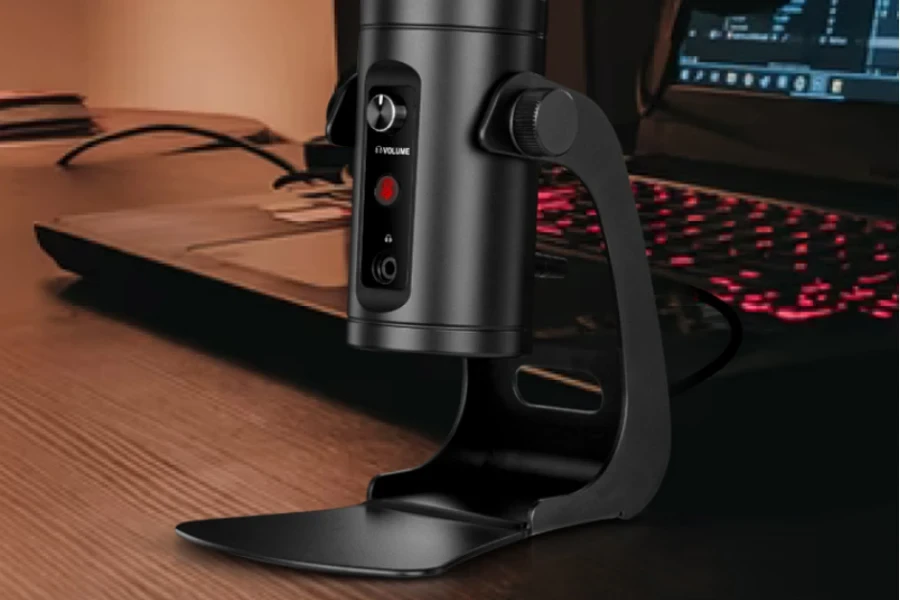
Enhancing the gaming experience
The right microphone design can significantly enhance the gaming and streaming experience, offering a blend of aesthetic pleasure, functional utility, and audio quality. Whether it’s through visual customization to express individuality or ergonomic features that ensure comfort and flexibility during long gaming sessions, the design and build quality of a microphone play pivotal roles in complementing and elevating a gaming setup.
In essence, understanding design and aesthetic appeal in gaming microphones involves considering how a microphone’s visual and functional aspects can integrate with and enhance a gaming or streaming environment. From ergonomic features and build quality to aesthetic customization, each aspect contributes to creating an immersive and visually cohesive gaming experience.
Spotlight on 2024’s leading gaming microphones
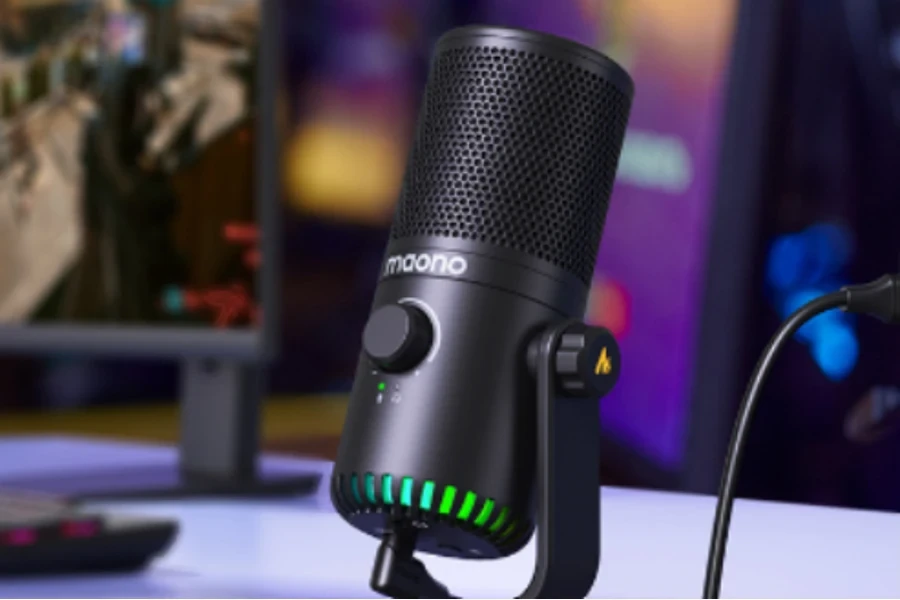
The gaming microphone market in 2024 showcases a variety of models designed to meet the diverse needs of gamers and streamers, from those seeking professional-grade audio fidelity to casual gamers looking for value and versatility.
Premium picks for professional streamers
In the realm of professional streaming, the audio quality can significantly impact the viewer’s experience, making the choice of microphone critical. Two models stand out for their exceptional performance, durability, and advanced features: the Shure SM7B and the Electro-Voice RE20.
Shure SM7B
The Shure SM7B is a dynamic microphone that has become a gold standard in the streaming and broadcasting industry, known for its smooth, flat, wide-range frequency response appropriate for both music and speech. Its ability to capture vocal nuances makes it a favored choice for professional streamers seeking broadcast-quality sound. The SM7B features a unique air suspension shock isolation system that virtually eliminates mechanical noise transmission, ensuring that only the speaker’s voice is captured without any background interference. Additionally, with its bass roll-off and mid-range emphasis controls, streamers can tailor the sound capture to their specific needs, enhancing clarity and presence in the mix. The microphone’s rugged construction and excellent shielding against electromagnetic hum make it exceptionally durable and reliable for long-term professional use.
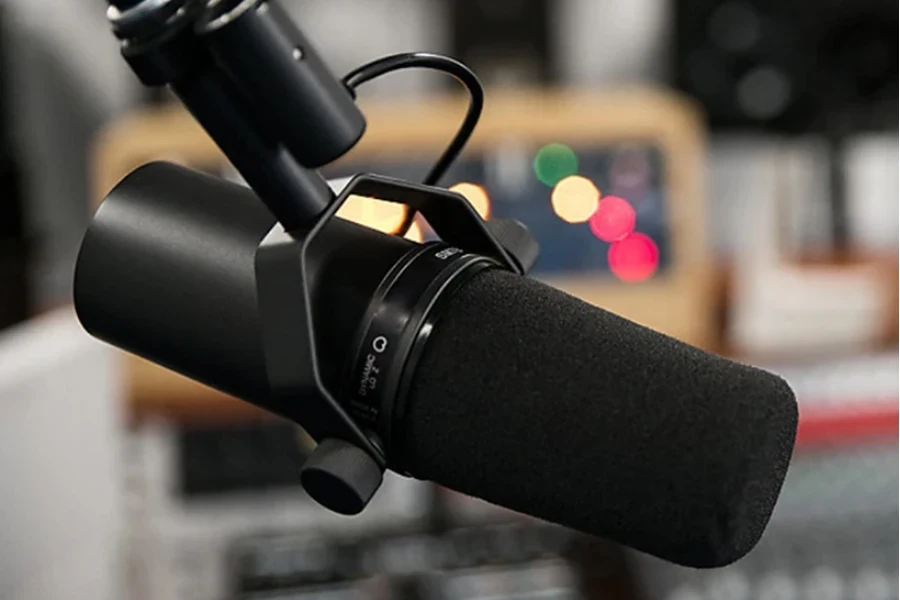
Electro-Voice RE20
The Electro-Voice RE20 is a cardioid dynamic microphone that offers a professional-grade audio solution for streamers and podcasters. Renowned for its Variable-D technology, the RE20 minimizes proximity effect, a common issue where sound quality changes depending on the distance of the speaker from the microphone. This feature ensures consistent sound quality, making it ideal for streamers who move around or change positions frequently. The RE20’s internal pop filter and bass roll-off switch provide additional control over sound quality, allowing users to reduce plosive noises and adjust low-frequency response to suit their environment and vocal characteristics. Its durable design and exceptional ability to handle high sound pressure levels without distortion make it a reliable choice for professional settings. The RE20’s distinctive look and performance have made it a staple in radio stations and recording studios, highlighting its capability to deliver superior audio quality for live streaming content.
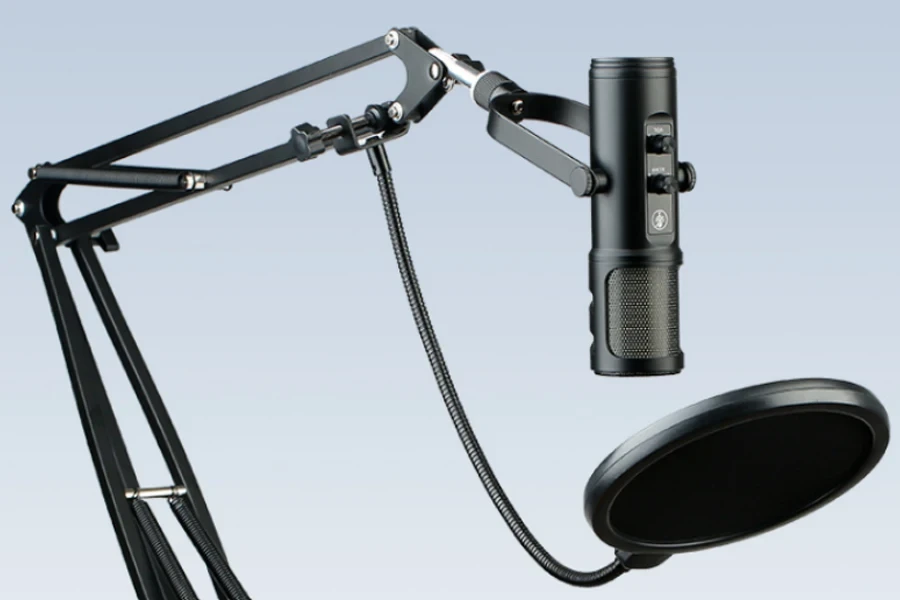
Both the Shure SM7B and Electro-Voice RE20 microphones exemplify what it means to combine professional-level audio quality with features that cater to the nuanced needs of professional streamers. Their advanced technology, durability, and the capacity for sound customization set them apart as premium choices in the competitive market of gaming microphones.
Best value microphones for casual gaming
For casual gamers, finding a microphone that balances audio quality, ease of use, and affordability is key. The Blue Yeti USB Microphone and the Razer Seiren Mini stand out in this category for their features that cater to gamers who want great performance without breaking the bank.
Blue Yeti USB Microphone
The Blue Yeti USB Microphone is a standout choice for gamers seeking professional-level audio without the complexity of professional gear. Known for its exceptional versatility, the Blue Yeti features tri-capsule technology that allows users to switch between four different pickup patterns (cardioid, bidirectional, omnidirectional, and stereo), making it suitable for a wide range of recording situations, from solo gameplays to group podcast sessions. This adaptability is complemented by its plug-and-play functionality, requiring no additional drivers for operation on both Windows and Mac computers.
The Yeti’s custom three-capsule array produces clear, powerful, broadcast-quality sound, which elevates the gaming experience for both the player and their audience. Its integrated controls for headphone volume, pattern selection, instant mute, and microphone gain put you in charge of every level of the recording process. Additionally, its sturdy design and adjustable stand make it a durable and flexible option for any desk setup. The Blue Yeti’s blend of quality and convenience, matched with its mid-range price point, represents an excellent value for casual gamers and streamers.
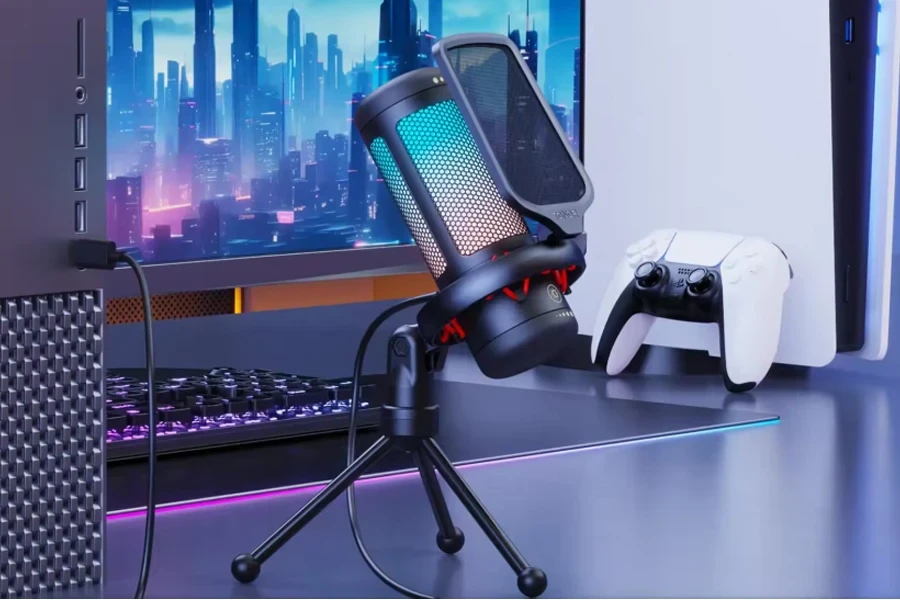
Razer Seiren Mini
For gamers with limited space or those who prioritize a minimalist setup, the Razer Seiren Mini offers a compact and sleek solution without compromising on sound quality. This ultra-compact condenser microphone is designed with a supercardioid pickup pattern, focusing on the user’s voice while minimizing background noise, which is ideal for gamers in busy environments.
Despite its small stature, the Seiren Mini is capable of delivering crisp and clear sound quality that rivals more expensive microphones, making it perfect for streaming and in-game communication. Its plug-and-play feature ensures compatibility with both PC and Mac without the need for any additional setup, offering immediate improvement to any gaming setup. The Razer Seiren Mini’s design is not only functional but also aesthetically pleasing, available in multiple colors to match any gaming rig or personality.
The combination of its compact design, superior sound pickup, and affordability makes the Razer Seiren Mini an attractive option for casual gamers looking to enhance their audio experience without a significant investment. It embodies the essential qualities of a cost-effective gaming microphone: simplicity, effectiveness, and a focus on what truly matters for gamers – clear communication.

Both the Blue Yeti USB Microphone and the Razer Seiren Mini represent the best in value for casual gamers, offering a mix of audio quality, versatility, and affordability. Whether gamers are streaming, communicating with teammates, or recording content, these microphones provide reliable and clear audio performance without the complexity or cost of professional audio equipment.
Innovative features in new market entrants
In the evolving landscape of gaming accessories, microphones have seen significant advancements, particularly in terms of spatial audio capabilities, customization, and ecosystem integration. Two models that exemplify these innovations are the HyperX QuadCast S and the Elgato Wave 3.
HyperX QuadCast S
The HyperX QuadCast S stands out for its incorporation of spatial audio capabilities, offering users an immersive audio recording experience. This feature is particularly beneficial for gamers and content creators looking to produce content with rich, life-like sound quality, making game streams and podcasts feel more dynamic and engaging. The QuadCast S boasts a vibrant RGB lighting system, which can be customized through HyperX’s NGENUITY software, allowing users to match their microphone’s lighting to their gaming setup or mood. This level of customization extends beyond aesthetics, as the microphone also features four selectable polar patterns (stereo, omnidirectional, cardioid, and bidirectional), providing versatility for various recording scenarios.
Another innovative aspect of the QuadCast S is its built-in shock mount and pop filter, which reduce vibrational noise and plosive sounds for clearer audio quality. Its tap-to-mute sensor with LED indicator offers convenience and control during live streams, ensuring that audio is only captured when intended. These features, combined with its USB plug-and-play connectivity, make the HyperX QuadCast S a compelling choice for gamers and streamers looking for a microphone that marries advanced audio technology with user-friendly functionality.

Elgato Wave 3
The Elgato Wave 3 is a condenser microphone designed with content creators in mind, offering pristine sound quality and advanced features geared towards seamless integration with gaming ecosystems. One of its standout innovations is the proprietary Clipguard technology, which automatically reduces sudden volume peaks to prevent clipping, ensuring consistent audio levels throughout streaming sessions. This is particularly useful during high-energy moments in gaming or when reacting to live chat interactions.
The Wave 3 also emphasizes customization and control through its Wave Link software, which allows users to mix multiple audio sources on their PC and create two independent mix outputs (one for the streamer and one for the audience). This level of control is invaluable for streamers who need to manage game audio, voice chat, and background music simultaneously, providing a professional audio mixing experience without the need for external mixers.
Furthermore, the Elgato Wave 3 features a USB-C connection for modern compatibility and a 24-bit analog-to-digital converter for superior sound capture. Its sleek design includes a capacitive mute button, a multifunctional dial for input gain, headphone volume, and crossfade adjustment between the microphone and PC audio. These features position the Elgato Wave 3 as a top choice for streamers and content creators seeking a high-quality, versatile microphone that integrates well with existing streaming software and hardware.
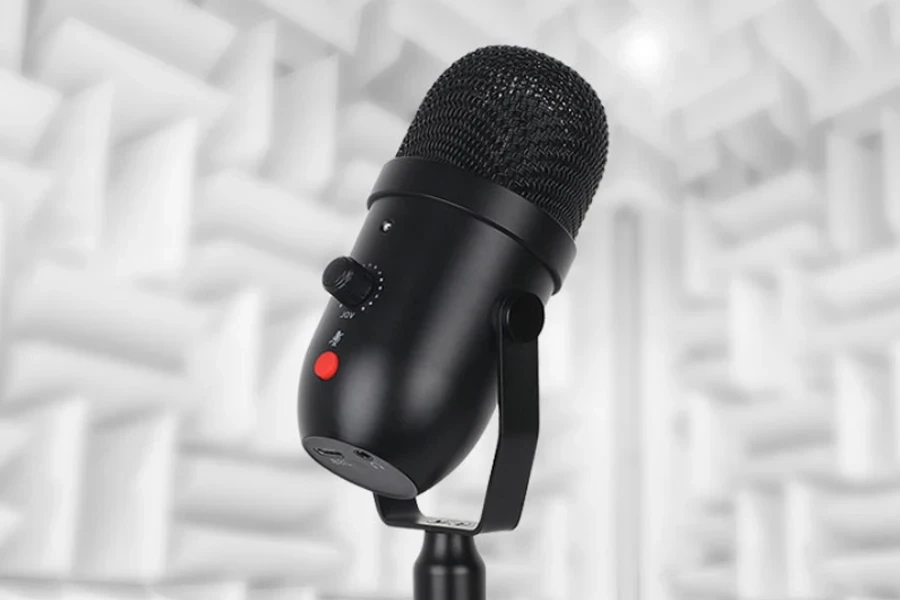
Both the HyperX QuadCast S and the Elgato Wave 3 represent the forefront of innovation in gaming microphones, offering features that enhance audio quality, provide extensive customization, and ensure seamless integration with gaming and streaming ecosystems. These microphones are designed to meet the demands of modern gamers and content creators, setting new standards for what gaming microphones can achieve.
The gaming microphone market in 2024 is characterized by a blend of high-quality audio performance, innovative features, and models designed to meet every budget. Whether for professional streaming, casual gaming, or content creation, the right microphone can significantly elevate the audio experience, contributing to the overall immersion and engagement of the audience.
Conclusion
Selecting the right gaming microphone in 2024 is pivotal for enhancing both gaming and streaming experiences, with options ranging from premium models for professionals to value picks for casual gamers, and innovative newcomers pushing the boundaries of audio technology. This guide has highlighted the importance of sound quality, compatibility, and design, showcasing models that cater to a variety of needs and preferences. Whether seeking broadcast-quality sound, plug-and-play convenience, or cutting-edge features, the market offers a microphone to elevate any gaming setup, underscoring the evolution of gaming microphones to meet the demands of today’s gamers and content creators.




